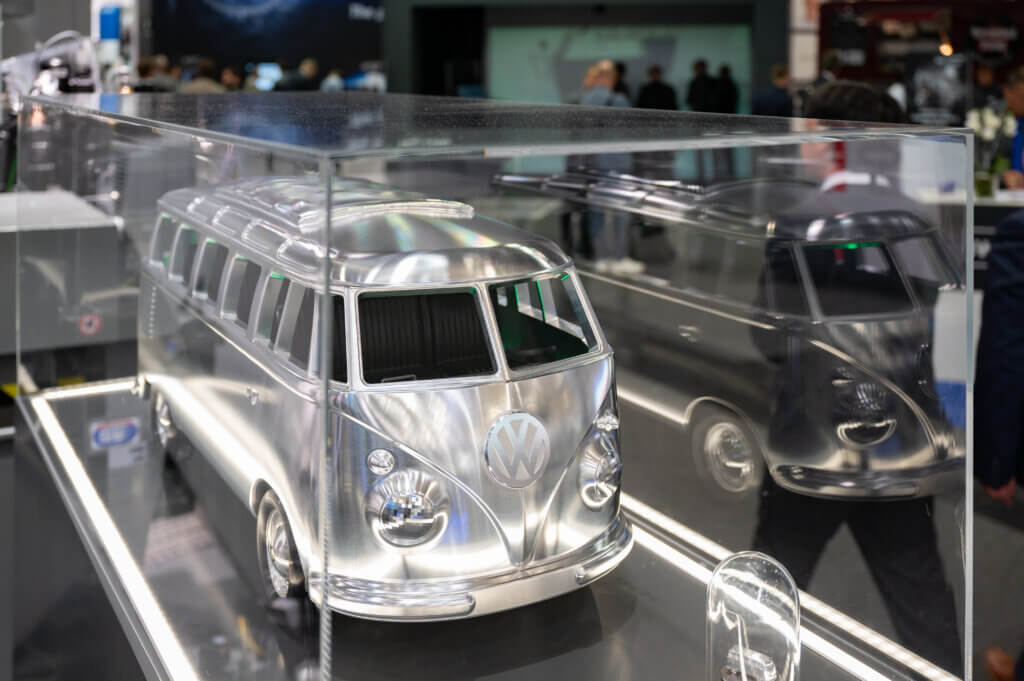How can process data from automobile production be recorded and used to increase energy and resource efficiency in production? What influence does the component quality of gearing elements such as drive shafts and axle drives have on noise generation in electric cars? Which grinding tools can be used to machine new materials and steels that are difficult to machine?
For 50 years now, the search for the most efficient machines, tools and systems has attracted trade visitors and experts from vehicle manufacturing and supplier companies to EMO Hannover, the world’s leading trade fair for production technology. The transformation of the automotive industry – the second largest customer for machine tools – is changing the focus of the EMO. Topics such as automation, digitalization and artificial intelligence mark the development. New drive concepts are raising questions as to whether the focus should be on the production of mechanical components for electric cars or compressor and motor shafts for fuel cells. Industry solutions for the circular economy or battery recycling are moving into focus because the regulatory framework is changing drastically. And the challenge above all else is to be as efficient and flexible as possible in order to be able to respond quickly to customer requests.
Efficient automobile factories for greater competitiveness
“Modern machine tools and innovative production systems are essential for building efficient, flexible and resilient factories,” stresses Dr. Markus Heering, Managing Director of EMO organizer VDW (Verein Deutscher Werkzeugmaschinenfabriken – German Machine Tool Builders’ Association). The trade fair concept is currently being presented on an international stage at the EMO World Tour. Under the motto “Innovate Manufacturing”, EMO stands for innovation, internationality, inspiration and the future of metalworking. At the same time, Heering underlines the trade fair’s expertise in industry solutions: “The machine tool industry is always in close contact with vehicle manufacturing companies,” he says.
In fierce international competition, especially with Chinese car manufacturers, the focus is on design, features, quality and costs. In order to assert themselves here, the modernization of factories is a pressing concern for both OEMs and medium-sized supplier companies. The modern factory features end-to-end process automation, precisely coordinated interfaces and integrated digitalization solutions. Machine tool manufacturers have come up with a solution and are equipping machines with extensive sensor and monitoring systems ex works. They provide the basis for data collection and analysis. The aim is to make it easier for customers to get started with data-driven production technologies in which processes can be visualized and optimized.
Digitalization is not an end in itself, emphasized Dr. Milan Nedeljković, Member of the Board of Management responsible for production at BMW AG, in a recent interview. Rather, it is an important enabler. The trend is towards integrated machine systems that can be used to manufacture comparatively small quantities in the powertrain area of electric cars just as economically, efficiently and reliably as mass products. The wide range of equipment variants and design features with which vehicle manufacturers want to incentivize buyers also require flexible production solutions.
Automation in a modular system
EMO Hannover 2025 picks up on such trends, for example with a wide range of automation solutions that can be implemented successively and also in conjunction with existing machines. Automation extends from simple solutions such as pallet changers and handling systems through to the use of robots and autonomous factories with self-driving systems. Secondary processes such as cleaning, labeling and measuring can be integrated. At the Cobot Area joint stand, for example, the focus will be on collaborative robots and their potential applications.
In order to support and relieve machine operators, assistance systems will be presented in which artificial intelligence can also be used. AI solutions can also be used for predictive maintenance and adaptive process management. The AI + Digitalization Area joint stand offers visitors from the automotive industry the opportunity to find out more about best practice examples.
Sustainability along the supply chain
The automotive industry is intensively discussing how energy and material consumption can be reduced in production. This was also demonstrated recently at the VDA (German Association of the Automotive Industry) Mobility Innovation Summit in Berlin. According to the EMO organizer VDW, investments in new machines already pay off, with energy savings of 25 percent. However, other levers can also be identified to make production processes more efficient and reduce carbon emissions. The Sustainability Area at EMO 2025 is a meeting place to discover modern solutions for sustainable production. Material efficiency plays a major role. With new simulation methods in component development and innovative production processes, for example, components can be designed to be even more resilient and durable.
The recyclability of vehicles must be ensured by taking recycling into account when developing new vehicle components. According to the VDA, around 85 percent of a vehicle is currently recyclable. Around a third of a new vehicle is made of secondary material. In order to further increase these quotas, a functioning circular economy must be set up in which all stakeholders work closely together and share their data. This involves production and material supply chains for several thousand components and parts that are installed in every vehicle. With regard to electromobility in particular, it is important to reuse batteries and recover lithium, nickel and cobalt for new batteries. These examples demonstrate the importance of close cooperation between development, production and vehicle construction. EMO Hannover 2025 is the best platform for cross-technology and cross-company discussions.
You can find out what EMO exhibitors have to offer their customers from the automotive and supplier industry in particular on the landing page in the run-up to the trade fair https://visitors.emo-hannover.de/en/landingpage/automotive/index. Here, EMO exhibitors will report successively on what visitors from the automotive sector can expect at their stand until the end of the EMO from September 22 to 26, 2025.
Skrrt
Author Cornelia Gewiehs
Downloads
Pictures
Picture 1 – 01 VW Bus

